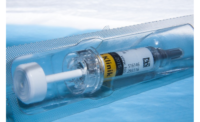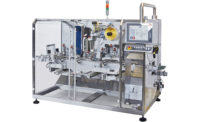Pharmaceutical packaging: The year of serialization

The Bottle Mosaic Station by Mettler Toledo provides marking, verifying and code linking for unoriented bottles.

Omega Design’s LabelSync 360 inspection and reject handling system captures codes, inspects caps and protects against contamination and tampering.

Amcor’s S.M.R.T. Bottle offers easy tracking and monitoring for effective drug compliance.

The Booklet-Label by Schreiner MediPharm offers a combination of digital security features like copy detection technology and chip authentication.




U.S. government-mandated serialization is creating a scramble in the pharmaceutical packaging world. Track and trace solutions must meet Drug Supply Chain Security Act (DSCSA) compliance by November of this year. Before the initial deadline, however, there are actions one must take to interact with the serial number – such as with product returns and suspect product investigations.
According to the report “Pharmaceutical & Medical Devices: Trends and Opportunities in Packaging Operations” by PMMI, The Association for Packaging and Processing Technologies, the push of serialization has led to an increase in aggregation adoption. In fact, of companies interviewed that are required to serialize their product, more than half have adopted aggregation.
One of the innovative products out in this segment is an electronic pill dispensing unit that offers easy tracking and monitoring, as well as single-tablet dispensing. Amcor Rigid Plastics (amcor.com) collaborated with Netherlands-based Confrérie Clinique (confrerie-
clinique.com) to develop The S.M.R.T. Bottle. The system delivers drug compliance, user friendliness, child and senior citizen safety, and connection to any smartphone for easy tracking and monitoring. It includes a clock-calendar function and unit dose tablet detector; registers the time, date and number of doses taken from the bottles; and stores the data. Using devices such as Near Field Communication (NFC) readers, the information contained in the memory can be read, displayed and transmitted to any smartphone.
The dispenser combines the benefits of a blister pack and a bottle in one package. The two-piece assembly can be designed for any pill bottle and existing filling lines with no changes required to the sealing process. The dispenser’s electronic system counts pills going in or out of the bottle, tracks the temperature of the container and ensures product integrity.
Schreiner MediPharm (schreiner-medipharm.com) introduces a customized Pharma-Security solution to safeguard the supply chain: a newly developed label that demonstrates a combination of digital security features on a Booklet-Label with an integrated first-opening seal. The bottom layer of the Booklet-Label contains a tab that serves as a closure seal for tampering protection. When the seal is opened, a void effect emerges as an irreversible first-opening indication. The Booklet-Label applied to a medicine pack allows a pharmacist, for instance, to view product information about the medication without opening the pack and thus destroying the tamper protection.
The sample label is equipped with three digital security features:
- BitSecure: A novel copy detection technology based on a high-resolution, cloud-like random pattern. In an attempt to copy BitSecure, the fake will suffer a loss in precision and optical details.
- KeySecure: The tracing system is based on an encrypted 15-digit alphanumerical code, which makes it possible to identify and authenticate every single product item marked via a smartphone or the Internet.
- Label-Integrated NFC Chip: The chip enables digital authentication using a smartphone, wherein the NFC chip blends in with the label design and allows for contactless product identification within a few centimeters.
The Bottle Mosaic Station (BMS) by Mettler Toledo (mt.com) carries out multiple steps in providing track & trace capability for round, unoriented bottles: marking, verifying and code linking. All integrated system components, such as the conveyor, printing system, high-resolution camera, product transfers and sorting equipment, are matched to ensure a seamless process. The Bottle Mosaic Station allows for quick changeover in a broad variety of product formats, as well as seamless upgrades.
Individual bottles are transferred directly from the production line filling system using an accurate transport unit. Regulation-specific data such as the serial number, batch and shelf life date, as well as the 2D datamatrix code are read precisely, and the helper code is printed on the bottle top or bottom. The BMS consists of the Mosaic Station, which incorporates six cameras for 360˚ inspection of labels and codes; a seventh camera for reading top and bottom helper codes and/or UV codes; a side grip to hold the package during bottom code reading; a printer to apply helper codes inline when needed; and a conveyor that moves bottles from station to station, and can be fitted as an option with a rejecter to remove non-conforming bottles.
Omega Design Corporation (omegadesign.com) recently introduces the LabelSync™ 360˚ inspection and reject handling system for bottles. Suitable for all markets, the unit captures codes, inspects caps, matches components and helps protect against food and allergen contamination, tampered/incorrect product, improper labeling and recalls. An integrated reject station along with fail-safe programming ensures that only verified product will move downstream. Adding a top or bottom camera can enable inspection and data syncing with a secondary line code, making possible the sort of unit-level product visibility that is increasingly being adopted around the globe. This SCADA-compatible system is ideal for food & beverage, consumer goods and medical, and can seamlessly integrate with MES and data management software.
Serialization and traceability consulting firm, Supply Chain Wizard (supplychainwizard.com), has just announced a partnership with Medicines for Europe, a pharmaceutical advocacy group. The company has plans to develop a similar relationship in the States.
In December, Supply Chain Wizard co-hosted the Pharma CMO Summit in Berlin, which gathered more than 100 pharmaceutical executives from 27 countries. Networking events that provided opportunity to exchange serialization advice and experiences with peers from around the world aided in the event’s success. The event also showcased ways in which serialization can go beyond mere regulation compliance to provide opportunities for enhanced business practices through data analytics produced by such systems.
The company is currently planning a serialization summit for CMO (pharmaceutical contract manufacturers and packagers) this spring in the U.S.
While working toward meeting the looming deadlines for the stricter regulations, the challenges you may face are not likely yours alone. Make sure to download the newest release of the GS1 U.S. (gs1us.org) guideline, “Applying GSI Standards for DSCSA and Traceability (R1.2).” Turn your informed plans into real-world solutions with help from organizations and companies that can offer assistance along the way. As well, reach out to peers in the market who may offer guidance.
Looking for a reprint of this article?
From high-res PDFs to custom plaques, order your copy today!











